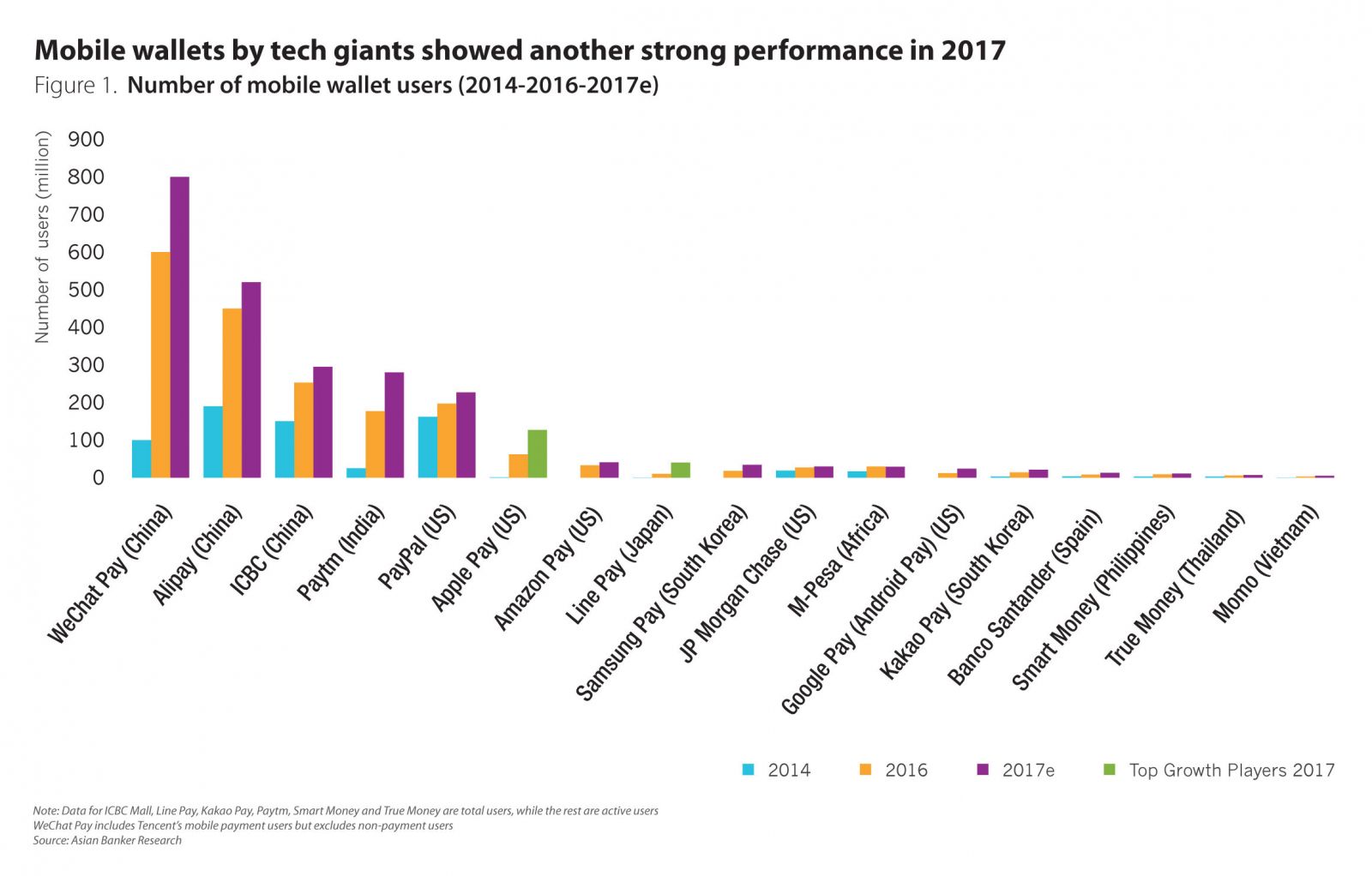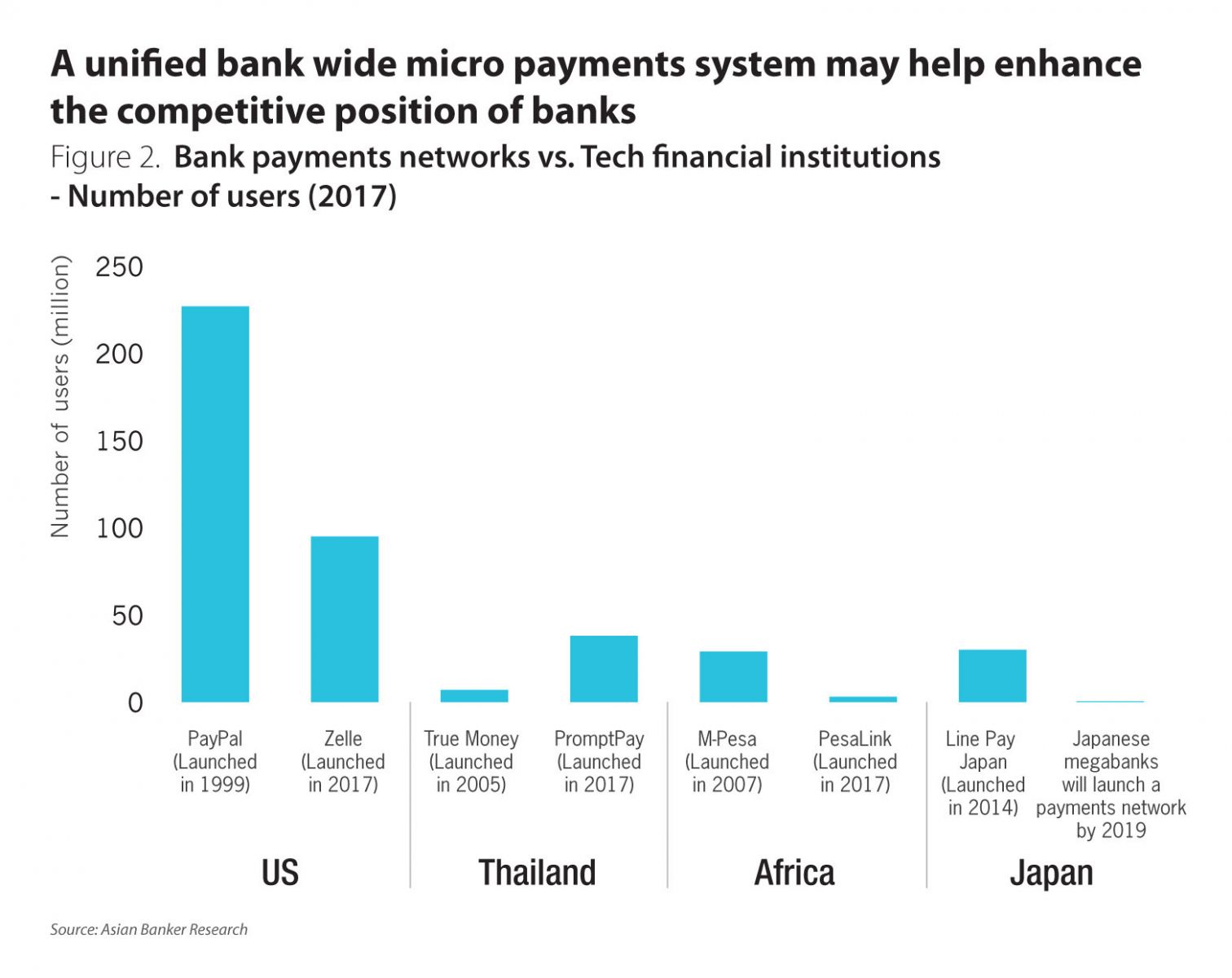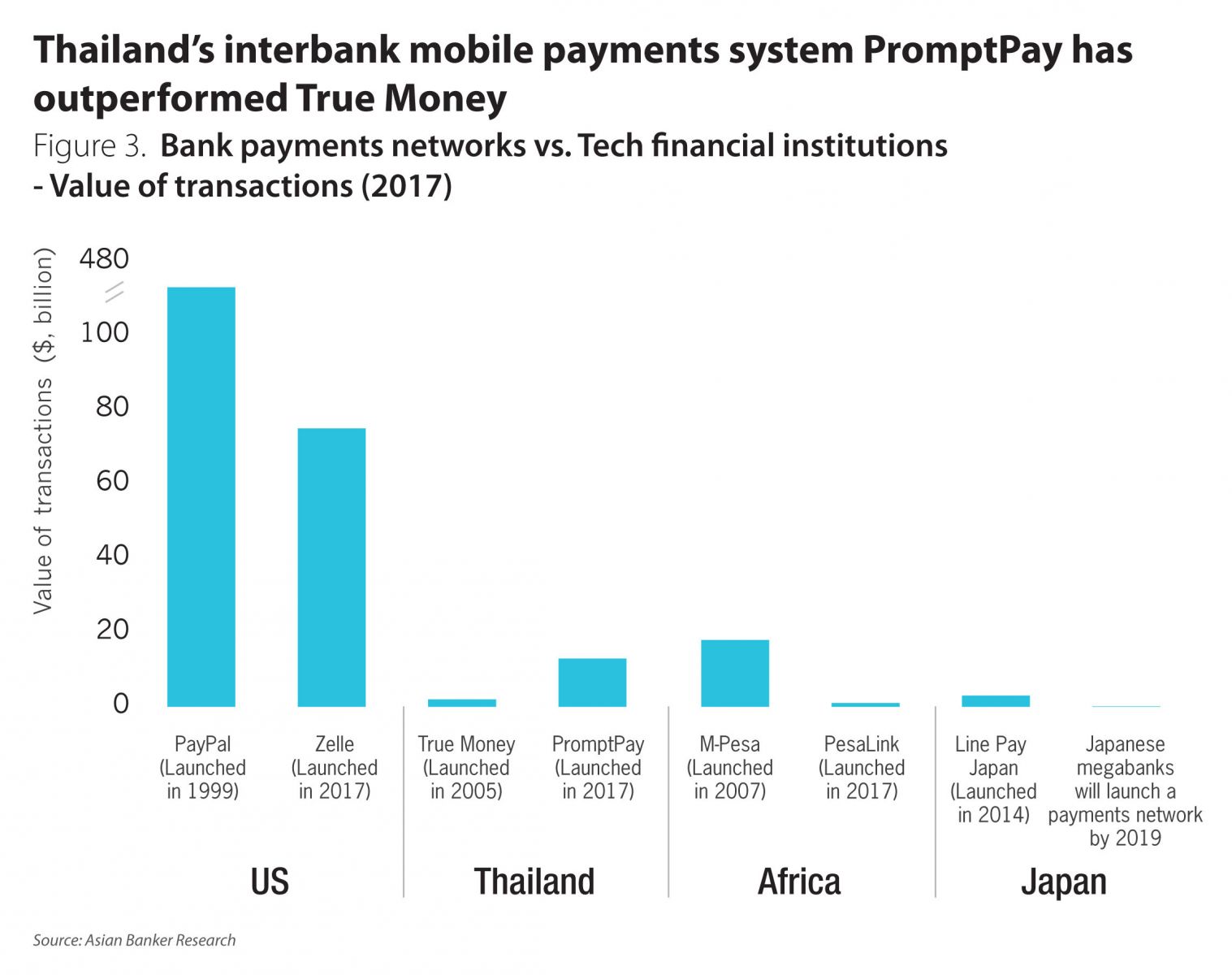- Large tech firms have strong brand recognition, direct relationship with wide user bases and immense data sets, while banks have advantages in other areas such as distribution and risk management
- There are indications that a unified bank wide micro payments system may enhance the competitive position of banks
- There will be more collaboration between banks and tech firms in search of better synergy
The financial services ecosystem is changing, and mobile wallet has become an important battleground among banks, tech companies and other players. Technology giants have emerged as major threats to banks on the ever-growing mobile payment landscape, forcing banks to exert more efforts to keep pace with digital disruptors and protect their share in the payments space.
Tech firms have achieved stronger mobile wallet user growth during the past few years, often fuelled by pre-existing popular messaging systems (Figure 1). For example, Tencent’s Wechat Pay, a mobile payments feature integrated into the WeChat messaging app, managed to catch up with leading payments player Alipay in a short period of time. WeChat hit one billion monthly active users in February 2018, and the number of WeChat Pay users reached around 800 million.

Many consumers are open to buying financial products from established tech firms. In terms of trust with their money, US and UK consumers ranked PayPal and Amazon nearly as high as banks, according to a survey by Bain & Company. Still, banks and tech firms cooperate with each other.
Large tech firms have strong brand recognition, direct relationship with wide user bases and immense data sets, while banks have advantages in other areas such as distribution and risk management. And these give them reasons to work together. For example, in China, the big four internet giants – Baidu, Alibaba, Tencent and JD.com – are all working with financial institutions in various areas to benefit mutually, as competition becomes increasingly fierce.
Tech firms are also moving into banking and some of them have been offering other financial products and services. In Europe, the growth of non-bank payment service providers is expected to be boosted by new regulations like Second Payment Services Directive (PSD2), which came into effect across the European Union in January 2018. Banks in EU are required to open their customer data to third parties, and non-banking firms, such as tech and telecoms companies, are allowed to provide financial services using data previously guarded by banks. In the US, tech giants also have urged regulators to require banks to make their customers’ financial data available to third parties via application programming interfaces (APIs). However, it remains to be seen how open banking is going to play out in the country.
The surge of tech platforms
WeChat Pay
In China, tech companies have dominated the mobile payment space. Alibaba Financial Group is the more rounded and comprehensive financial service provider with one exception – peer-to-peer payments (P2P) payments. Tencent leads in terms of P2P payments, with 300 million more users than Alipay. The digital version of the traditional “red envelope”, launched in January 2014, helped Tencent’s WeChat Pay establish its early user base. The company then partnered with China Central Television (CCTV) as its official red envelope distributor during the five-hour Spring Festival Gala show in 2015, which was the single biggest driver in overtaking Alipay.
WeChat Pay and Alipay are not only engaged in an ongoing battle to win over retailers across China, but are also fighting over the large amount of Chinese tourists spending abroad. WeChat Pay has partnered with international merchants to handle transactions in 25 countries and regions, supporting 13 different currencies. It allowed Chinese tourists to pay overseas merchants in Renminbi, while enabling merchants to receive the funds in their local currencies.
In January 2018, WeChat Pay partnered with Swiss firm Global Blue in offering an instant tax refund service at Madrid airport in Spain, which gave Chinese travellers rebates on purchases made through WeChat Pay. The two companies are also working on an in-store early refund solution, which will be launched across Europe within 2018. With the service, Chinese tourists will receive their tax refund instantly through their WeChat Pay wallet while still in-store. In addition, Chinese tourists traveling abroad got a chance to receive digital red envelopes during the Chinese New Year 2018, when shopping at participating overseas merchants.
Line Pay
Line Pay, launched in December 2014, has recorded dramatic growth in core markets including Japan, Taiwan and Thailand. It registered more than 40 million global users, up from 10 million in February 2017. In Japan, Line Pay has surpassed 30 million registered users and has teamed up with 48 major banks to further boost.
The physical Line Pay Cards and Line New Year’s Gift campaign have contributed to the rapid user growth in Japan. In March 2016, Line Pay began issuing physical Line Pay Cards, which gave 2% purchase rebates distributed via Line Points. During the Line New Year’s Gift campaign, held between December 27, 2016 and January 3, 2017, users were allowed to send virtual messages with the chance to win “lucky money” in the form of LINE Pay credit. In addition, in January 2017, Lawson convenience stores added a new code payment service across Japan, where users can make purchases by showing a code displayed on their smartphones at the register.
However, Line Pay can only be used at about 16,000 vendor sites including convenience stores. To attract more users, Line stepped up the promotion of its mobile platform to vendors across Japan, seeking to make it available to some one million locations by 2020. Line also collaborates with local banks and other payment service providers in Taiwan, Thailand and Indonesia to boost user growth, with specialised promotions for each market.
Apply Pay
The adoption of Apple Pay was slower than what Apple anticipated when it was introduced in October 2014. Although PayPal remains preferred in the United States, Apply Pay achieved more impressive growth in 2017, mainly because it has expanded to more international markets and has been accepted by more retailers. The number of active Apple Pay users doubled over the last 12 months, and transactions more than tripled, according to the latest results released by the company.
Apple Pay has reached more than 20 countries and has been working with more than 4,000 issuers. In the United States, Apple Pay is accepted at more than half of all retail locations, including two-thirds of the country’s top 100 retailers. The support for the mobile payments platform by businesses and financial institutions has also increased.
However, the percentage of active iPhones users who have turned on Apple Pay is still relatively small. Despite the slow adoption, Apple Pay dominates the contactless payment transaction market with over 90% market share. The adoption and usage of Apple Pay has been less robust in the United States than in international markets. Three out of four of Apple Pay transactions happen outside the United States, mainly because contactless and mobile payment has been far more widespread in Europe and Nordic countries.
Unified bank wide micro payments system
There are indications that a unified bank wide micro payments system may enhance the competitive position of banks (Figure 2). Such system that enables small- value transfers between institutions has been proven successful in competing with large technology firms in micro payments.

For example, in Kenya, the total number of mobile money accounts surpassed the total number of bank accounts in 2009. But bank accounts have exceeded the total number of mobile money accounts in 2014, according to the Consultative Group to Assist the Poor (CGAP)’s working paper, Banking in the M-PESA Age: Lessons from Kenya. One of the key strategies employed by Kenyan banks is “industry coordination” to create alternatives to existing mobile money products.
Kenyan banks have traditionally relied on M-Pesa mobile money transfer service in connecting customers to their accounts. But in February 2017, The Kenya Bankers Association (KBA) launched an interbank money transfer service called Pesalink. PesaLink is operated by Integrated Payments Service Limited (IPSL), a fully-owned subsidiary of KBA. The service enables consumers to make mobile payments from $0.10 (KES 10) up to $9,650 (KES 999,999) across the banking system in real time and around the clock, without the need to go through traditional intermediaries.
“What PesaLink demonstrates is that KBA and the member banks are aware of their duty to serve customers, innovate and create value for our economy,” says John Gachora, vice chairman, KBA.
“It is proof that the banking industry has embraced the technology revolution sweeping across the payments industry. It is through such innovations that Kenya earns its title as a global leader in fintech innovation,” he added.
In the U.S., Zelle, the person-to-person payments network backed by major U.S. banks and credit unions, enables payments from one bank account to another through an e-mail address or a U.S. mobile phone number. It is a re-branding of an existing network called clearXchange that offered payment services through member financial institutions and a website. Zelle launched its standalone mobile app for both Apple and Android users in September 2017, and competes directly with PayPal’s Venmo and Square’s Cash app.
Zelle had around 95 million customers in January 2018, including those who have access to the service through its partnership with over 60 financial institutions. In 2017, Zelle processed more than twice as much in payments as Venmo, as measured by dollar volume.
However, it lacks brand recognition. Thus, big U.S. banks are spending millions of dollars to persuade millennials to use Zelle.
In January 2017, Thailand’s main interbank payments provider National ITMX worked with Mastercard’s Vocalink unit to launch PromptPay, an interbank mobile payment system under the national e-payment initiative (Figure 3). PromptPay has managed to capture a sizable portion of the Thai market, and is outdoing True Money, considered the largest single e-wallet provider in the country. It had 39 million registrants a year after it was launched, with $15.7 billion (THB490 billion) in transaction value and 127 million in transaction volume, according to Bank of Thailand. Meanwhile, 66% of registered customers used their ID cards in dealing with the public sector and in claiming tax refunds, while 44% used mobile phone numbers. The Monetary Authority of Singapore and the Bank of Thailand have agreed to work together to link PayNow and PromptPay, which will allow people in their countries to send money to each other using their mobile phone numbers, at any time of the day.

In Japan, the three megabanks, Mitsubishi UFJ Financial Group, Mizuho Financial Group and Mitsui Financial Group, are cooperating to create a standardised QR code-based mobile payment system. It is believed to be a good start that could help to facilitate mobile payments and promote cashless transactions in the country. The three megabanks estimate that it will cost over $9 million, and the new system is expected to go live in the fiscal year 2019. A jointly-financed third party will be established to oversee the overall system.
Overall, banks appear to be able to catch up and stay competitive. Many of them have created partnerships with tech companies to upgrade their products and services and attract new customers in new platforms to expand their income sources. In addition, unified bank wide micro payments systems have been launched in some markets, which helped banks improve their competitiveness. Going forward, we expect to see more collaboration between banks and tech firms in search of better synergy, and banks should continue with their efforts to create platforms or find other highly innovative solutions to combat the threat.

































